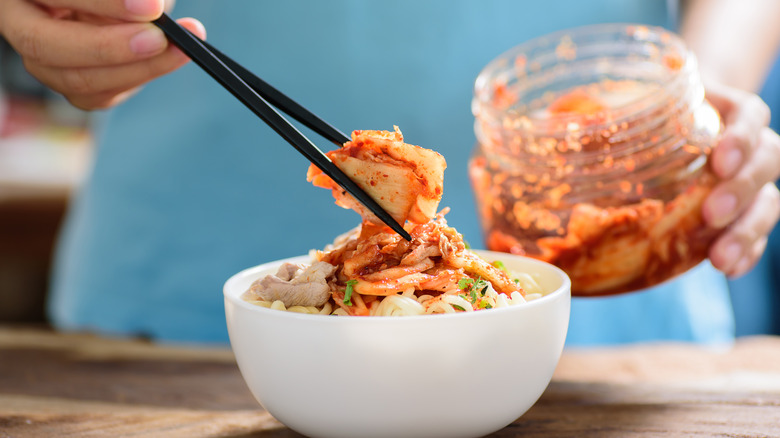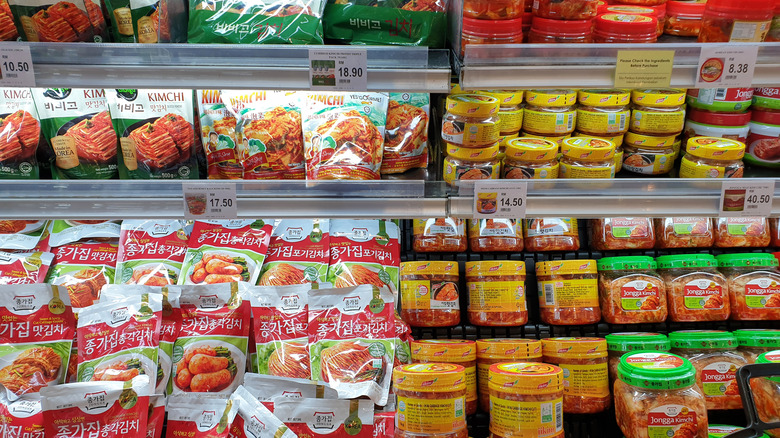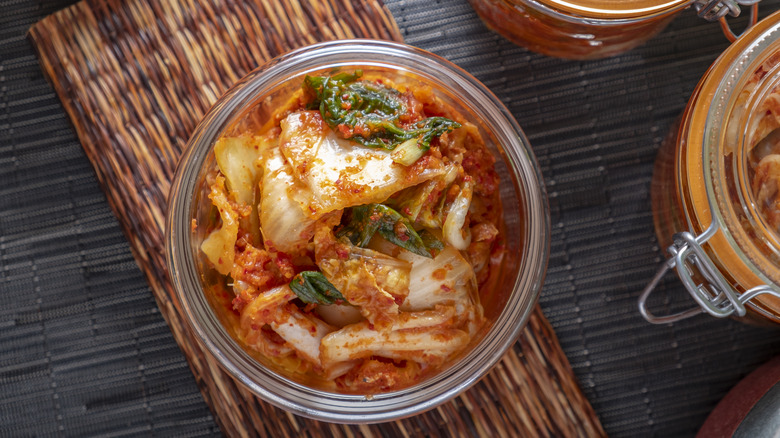The Absolute Best Temperature To Store Kimchi At
Kimchi, aka Korean pickled vegetables, has become a staple in many American homes, regardless of heritage or descent. For non-Korean Americans, the version of kimchi most familiar is probably baechu kimchi, the popular spicy Napa cabbage recipe spiked with gochugaru chili pepper flakes. The combinations of crunchy and soft textures, spice, umami, and vegetable tanginess are hard to beat.
These days, kimchi gets incorporated into everything, including inventive samosas, empanadas, and grilled cheese sandwiches. But whether you're buying a giant jar at the grocery store or making your own, there's almost always extra, which means storing what's left. Properly cooled, Kimchi will stay crisp for three or more months after opening a jar or packet, and remain tasty for six or more months. But what's the best temperature and way to store all that spicy pickled goodness for maximum preservation? Well, keeping it below 39 degrees Fahrenheit should become your mantra.
It's important to remember that kimchi and gimjang or kimjang — the seasonal traditions around making and sharing kimchi — are intrinsic to Korean culture and have roots dating back two millennia or more. So although it is a fun and versatile side dish and an excellent ingredient to upgrade literally anything from soup to nuts, its history and importance to many people of North and South Korea should always be kept in mind.
The coldest part of your refrigerator is best
No matter the ingredients (kimchi can include seafood as well as any veggies), the most defining characteristic of kimchi is the cool-temperature fermentation process it undergoes. Traditionally, ingredients were fermented in jars underground, and the dish was intended to get families through Korea's long winters. Understanding weather patterns and the optimal temperatures for fermentation and storage was key not only to tasty food, but survival.
You can make kimchi in glass jars at home in just a few days, but the physics remain the same. Once fermented, the goal is to keep it stored between about 39 degrees Fahrenheit and freezing, or 32 degrees Fahrenheit. This is the case both during traditional slow fermentation (gimjang is best celebrated when the highs are below 39 degrees Fahrenheit, and nights get below freezing), and for long-term storage. Above 39 degrees Fahrenheit, the food risks spoilage and harmful bacteria. If it's freezing, it will kill the fermentation process.
It just so happens that 35 to 38 degrees Fahrenheit is the sweet spot for your refrigerator, perfect for storing kimchi. Avoid storing in the doors, as they tend to be the warmest parts of the fridge, and opening and closing the doors creates temperature fluctuations. The crisper is the coldest part, if you have room. Otherwise, use the rear and bottom of the refrigerator. Experts recommend against freezing kimchi as it kills the ongoing fermentation process, and crystallizes the ingredients, altering their texture upon thawing.
Other tips for storing kimchi
Like many other fermented foods, kimchi contains probiotics (good bacteria and yeasts) that foster fermentation. Unlike some fermented foods, the microorganisms stay active, and the fermentation process continues as long as it's properly stored (slowing in the cool temperature). In addition to reaping the benefits of active probiotics, it means your kimchi will continue to evolve. Sour and umami notes intensify over months of storage. If that's not your thing, finish a batch within a couple of weeks. If you like more fermentation, use this simple hack to improve store-bought kimchi.
Oxygen is an enemy to long-term storage, as it promotes both oxidation and can introduce mold spores. So if your batch is in a zip-top plastic bag, squeeze the air out each time you close the bag. If it's in a large jar, consider repackaging what's left into smaller jars or resealable plastic tubs. Cover the solids with as much remaining liquid as possible. Always use clean utensils (and not your hands) when dishing out a serving. Again you're reducing the risk of introducing mold or bad bacteria.
If white spots appear, don't worry! That's just yeast blooming, and is not harmful. Scrape it off and cook kimchi to keep enjoying. However if your pickled treats smell off (bad, not sour), or you see mold growing on top, toss the whole thing.


